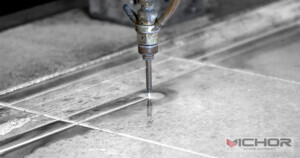
Water Jet Cutting Through Steel: The Future of Metal Fabrication
Imagine a tool so powerful it can slice through inches of solid steel, yet so gentle it can etch intricate patterns without altering the material’s inherent structure. This isn’t science fiction; it’s the reality of water jet cutting through steel. This advanced manufacturing process has revolutionized how industries handle metal fabrication, offering a unique combination of brute force and delicate precision. Unlike traditional methods that rely on heat, this technology harnesses the raw power of water and abrasives, making it a go-to solution for projects demanding the highest levels of accuracy and material integrity. Let’s dive into the mechanics and advantages of this fascinating technology.
The Core Principle: How a Water Jet Slices Steel
At its heart, the process of water jet cutting through steel is a masterclass in focused energy. It’s a common misconception that pure water is used to cut metal. For hard materials like steel, the system employs an abrasive water jet. The process begins with a high-pressure pump that intensifies ordinary water to extreme pressures, often exceeding 60,000 PSI (Pounds per Square Inch). This ultra-high-pressure stream is then forced through a tiny orifice, typically made of sapphire or diamond, creating a supersonic jet of water.
However, pure water alone would simply deflect off a steel surface. This is where the abrasive comes in. Just after the water jet exits the orifice, it enters a mixing tube where a precise amount of garnet abrasive is sucked into the stream via a vacuum effect. The water accelerates these hard, granular particles, transforming the stream into a potent erosive tool. It is this continuous, high-velocity abrasive slurry that microscopically grinds away the steel, allowing for the precise water jet cutting through steel we observe. The result is a clean, narrow kerf (the width of the cut) with a smooth, satin-like finish.
The Unmatched Advantage: A Cold Cutting Process
One of the most significant benefits of using a water jet cutting through steel is that it is a cold cutting process. Traditional thermal cutting methods like plasma, laser, or oxy-fuel cutting generate intense heat. This heat creates a Heat-Affected Zone (HAZ) along the edges of the cut. The HAZ can alter the metallurgical properties of the steel, causing hardening, warping, micro-fractures, or changes in temper, which can compromise the part’s structural integrity and require secondary processing.
Since water jet cutting through steel involves no heat, it completely eliminates the HAZ. The material remains at ambient temperature throughout the process, preserving its original strength, hardness, and internal structure. This is critically important for materials like tool steel, armor plating, and hardened steels, where any thermal alteration could render the component useless. The cold nature of the cut also means there is no thermal stress-induced distortion, ensuring the final part retains its precise dimensional accuracy.
Precision and Versatility in Complex Shapes
When it comes to complexity and precision, few technologies can rival the capabilities of a water jet cutting through steel. The stream is controlled by a computer numerical control (CNC) system, which guides the cutting head with exceptional accuracy, often within a tolerance of +/- 0.003 inches. This allows for the creation of incredibly intricate shapes, sharp corners, and fine details that would be difficult or impossible to achieve with mechanical tools or thermal cutters.
This versatility is a key reason why industries from aerospace to architecture rely on water jet cutting through steel. Whether it’s producing complex gears, detailed artistic sculptures, custom machine components, or prototypes, the water jet handles it all with ease. Furthermore, because there is no physical tool contact, there is no tool wear or breaking associated with cutting hard materials, ensuring consistent quality from the first part to the last.
Material and Thickness Capabilities
The ability of water jet cutting through steel is not limited to a specific type or thickness. This process can handle a wide range of ferrous metals, including mild steel, stainless steel, tool steel, and armor plate. While the cutting speed is inversely related to the material’s thickness and hardness, water jets are capable of cutting steel plates up to 12 inches thick, and even thicker in some cases.
This makes it an incredibly flexible solution for both thin, delicate parts and massive, heavy-duty components. Unlike lasers, which can struggle with reflective materials or very thick sections, and plasma, which leaves a beveled edge on thicker materials, water jet cutting through steel provides a straight, clean edge from top to bottom, regardless of thickness.
Environmental and Operational Considerations
In an increasingly eco-conscious world, water jet cutting through steel presents several environmental and operational advantages. The primary cutting medium is water, which is naturally abundant and can be recycled and reused within a closed-loop system after filtering. The abrasive used, typically garnet, is a non-toxic, natural mineral. While the used abrasive becomes a waste product, it is inert and can often be recycled for other applications, such as sandblasting or construction filler.
From an operational standpoint, the process is relatively clean, producing no hazardous fumes or vapors since there is no combustion or melting. However, it is a noisy process and generates significant splashback, requiring the machine to be fully enclosed. The key operational consideration is the trade-off between the unparalleled quality and versatility of the cut and the slower cutting speeds compared to plasma for thicker materials and higher operational costs due to abrasive and pump maintenance.
Water jet cutting through steel stands as a testament to engineering innovation, turning the simple combination of water and sand into one of the most versatile and reliable cutting tools available. Its ability to cut without heat, handle immense thicknesses, produce intricate designs with razor-sharp precision, and do so in an environmentally responsible manner makes it an indispensable technology in modern manufacturing. For any project where the integrity of the steel is as important as the shape it takes, water jet cutting through steel is often the unequivocal choice.
Frequently Asked Questions (FAQs)
Q1: How thick of a steel plate can a water jet cut through?
A1: Industrial-grade abrasive water jets are capable of water jet cutting through steel with thicknesses exceeding 12 inches. The practical limit depends on the specific machine’s pressure and the type of steel, but it is one of the most effective methods for cutting very thick metal plates with a consistent edge quality.
Q2: Does water jet cutting leave a rough edge on the steel?
A2: The edge quality from water jet cutting through steel is typically very smooth, with a satin-like finish. However, a slight taper and a progressively smoother surface from the top to the bottom of the cut can occur. For applications requiring a perfectly square edge, this can be minimized with advanced cutting techniques or speed adjustments.
Q3: Is water jet cutting more expensive than laser or plasma cutting for steel?
A3: The operational cost of water jet cutting through steel is generally higher than plasma and can be higher than laser for thinner materials due to the cost of abrasives and pump maintenance. However, it becomes highly cost-competitive and often more economical for thicker materials, complex shapes, and when the elimination of heat damage eliminates costly secondary processing.
Q4: What types of steel can be cut with a water jet?
A4: The process of water jet cutting through steel is highly versatile and can cut virtually any type of steel, including mild steel, carbon steel, stainless steel, tool steel, galvanized steel, and even armor plate. The hardness of the steel does not affect the jet’s ability to cut; it only influences the cutting speed.
Q5: How does the precision of a water jet compare to a laser cutter for steel?
A5: Both technologies offer high precision. Lasers can sometimes achieve slightly tighter tolerances on thin, non-reflective metals and are faster. However, water jet cutting through steel maintains its precision regardless of the material’s thickness or reflectivity and does so without creating a heat-affected zone, making it the more precise option for applications where material integrity is paramount.
continue reading


